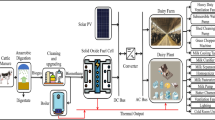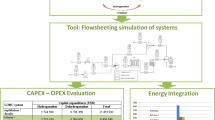Abstract
Alternative thermoeconomic models that propose novel concepts to solve both dissipative component and waste problems have been published such as H&S Model and UFS Model. These models have been applied to carry out cost and/or environmental impact allocations, and operational diagnosis. Thus, they were not applied to perform cost assessments for systems improvement. In this paper, both H&S and UFS models are concomitantly applied to an Organic Rankine Cycle coupled to a vapor-compression refrigeration cycle, being the H&S applied to the power cycle and the UFS applied to the refrigeration cycle. The objective is to verify whether both thermoeconomic approaches can be applied to obtain the exergoeconomic variables of both cycles. The exergoeconomic variables analyzed in this study are the exergetic efficiency (product-fuel ratio), cost rate of exergy destruction, sum of component investment and exergy destruction cost rates, relative cost difference, and exergoeconomic factor. In addition, a parametric analysis of these variables is done. To better analyze the results from the application of both H&S and UFS models, Specific Exergy Costing is applied as well. The results show that there is a limitation in the boiler exergoeconomic modeling considering both Specific Exergy Costing and H&S Model. This is due to the zero cost of the system’s overall fuel, which can be considered a singularity. In general, both H&S and UFS models can be applied to obtain the exergoeconomic variables of systems that undergo thermodynamic cycles.














Similar content being viewed by others
Abbreviations
- c :
-
Unit exergoeconomic cost
- f :
-
Exergoeconomic factor
- r :
-
Relative cost difference
- y :
-
Relative exergy destruction
- \(\dot{C}\) :
-
Cost rate
- CRF:
-
Capital recovery factor
- Ė :
-
Exergy rate
- \(\dot{F}\) :
-
Flow work term
- \(\dot{H}\) :
-
Enthalpic term
- IF:
-
Installation factor
- PEC:
-
Purchase equipment cost
- \(\dot{Q}\) :
-
Heat transfer rate
- \(\dot{S}\) :
-
Entropic term
- T :
-
Temperature
- \(\dot{U}\) :
-
Internal energy term
- \(\dot{W}\) :
-
Power
- \(\dot{Y}\) :
-
Generic productive flow
- \({\dot{{Z}}}\) :
-
Component cost rate
- ε:
-
Exergetic efficiency
- η:
-
Isentropic efficiency
- τ:
-
Hours of operation per year
- 0:
-
Environment
- blr:
-
Boiler
- cmp:
-
Compressor
- cnd:
-
Condenser
- evp:
-
Evaporator
- in:
-
Inlet
- k:
-
K-th component
- orc:
-
Organic Rankine Cycle
- out:
-
Outlet
- pmp:
-
Pump
- trb:
-
Turbine
- vcr:
-
Vapor compression refrigeration
- vlv:
-
Valve
- C:
-
Cold thermal reservoir
- D:
-
Exergy destruction
- F:
-
Fuel
- H:
-
Hot thermal reservoir
- P:
-
Product
References
Tsatsaronis G (2007) Definitions and nomenclature in exergy analysis and exergoeconomics. Energy 32:249–253. https://doi.org/10.1016/j.energy.2006.07.002
Frangopoulos CA (1987) Thermo-economic functional analysis and optimization. Energy 12:563–571. https://doi.org/10.1016/0360-5442(87)90097-1
Lozano MA, Valero A (1993) Theory of the exergetic cost. Energy 18:939–960. https://doi.org/10.1016/0360-5442(93)90006-Y
Erlach B, Serra L, Valero A (1999) Structural theory as standard for thermoeconomics. Energy Convers Manag 40:1627–1649. https://doi.org/10.1016/S0196-8904(99)00057-6
Lazzaretto A, Tsatsaronis G (2006) SPECO: A systematic and general methodology for calculating efficiencies and costs in thermal systems. Energy 31:1257–1289. https://doi.org/10.1016/j.energy.2005.03.011
Torres C, Valero A, Rangel V, Zaleta A (2008) On the cost formation process of the residues. Energy 33:144–152. https://doi.org/10.1016/j.energy.2007.06.007
Seyyedi SM, Ajam H, Farahat S (2010) A new criterion for the allocation of residues cost in exergoeconomic analysis of energy systems. Energy 35:3474–3482. https://doi.org/10.1016/j.energy.2010.04.047
Agudelo A, Valero A, Torres C (2012) Allocation of waste cost in thermoeconomic analysis. Energy 45:634–643. https://doi.org/10.1016/j.energy.2012.07.034
A.S. Dogonchi, S.M. Seyyedi, Two New Alternative Options for Residues Cost Distribution Ratio, J. Appl. Dyn. Syst. Control. Vol 1 (2018) 28–36. http://jadsc.aliabadiau.ac.ir/article_545935.html.
A. Sagastume-Gutierrez, J.J. Cabello-Eras, H. Hernandez-Herrera, Thermoeconomic Evaluation and Exergy Efficiency of Dissipative Components: A New Approach, J. Eng. Appl. Sci. 13 (2018) 2560–2569. http://medwelljournals.com/abstract/?doi=jeasci.2018.2560.2569.
Denise L-MH, Vicente T-GE, Sergio C-H, Martín S-P, Teresa L-A, Raúl L-L (2020) An irreversibility-based criterion to determine the cost formation of residues in a three-pressure-level combined cycle. Entropy 22:299. https://doi.org/10.3390/e22030299
Helen L-M, Sergio C-H, Martín S-P, Javier V-L, Vicente T-GE, Raúl L-L (2020) Residue cost formation of a high bypass turbofan engine. Appl Sci 10:9060. https://doi.org/10.3390/app10249060
Uysal C, Kwak H-Y (2020) Role of waste cost in thermoeconomic analysis. Entropy 22:289. https://doi.org/10.3390/e22030289
Torres C, Valero A (2021) The exergy cost theory revisited. Energies 14:1594. https://doi.org/10.3390/en14061594
Santos JJCS, Nascimento MAR, Lora EES, Martínez-Reyes AM (2009) On the negentropy application in thermoeconomics: a fictitious or an exergy component flow? Int J Thermodyn 12:163–176
Lourenço AB, Nebra SA, Santos JJCS, Donatelli JLM (2015) Application of an alternative thermoeconomic approach to a two-stage vapour compression refrigeration cascade cycle. J Brazilian Soc Mech Sci Eng 37:903–913. https://doi.org/10.1007/s40430-014-0210-7
Dos Santos RG, De Faria PR, Santos JJCS, Da Silva JAM, Donatelli JLM (2015) The effect of the thermodynamic models on the thermoeconomic results for cost allocation in a gas turbine cogeneration system. Rev Eng Térmica 14:47. https://doi.org/10.5380/reterm.v14i2.62133
Santos RG, Faria PR, Santos JJCS, Silva JAM, Flórez-Orrego D (2016) Thermoeconomic modeling for CO2 allocation in steam and gas turbine cogeneration systems. Energy 117:590–603. https://doi.org/10.1016/j.energy.2016.04.019
da Silva JAM, Santos JJCS, Carvalho M, de Oliveira S (2017) On the thermoeconomic and LCA methods for waste and fuel allocation in multiproduct systems. Energy 127:775–785. https://doi.org/10.1016/j.energy.2017.03.147
Lorenzoni RA, Conceição Soares Santos JJ, Barbosa Lourenço A, Marcon Donatelli JL (2020) On the accuracy improvement of thermoeconomic diagnosis through exergy disaggregation and dissipative equipment isolation. Energy. https://doi.org/10.1016/j.energy.2019.116834
Fortes AFC, Carvalho M, da Silva JAM (2018) Environmental impact and cost allocations for a dual product heat pump. Energy Convers Manag 173:763–772. https://doi.org/10.1016/j.enconman.2018.07.100
Picallo-Perez A, Sala JM, del Portillo L, Vidal R (2021) Delving into thermoeconomics: a brief theoretical comparison of thermoeconomic approaches for simple cooling systems. Front Sustain. https://doi.org/10.3389/frsus.2021.656818
Pektezel A (2019) Energy and exergy analysis of combined organic rankine cycle-single and dual evaporator vapor compression refrigeration cycle. Appl Sci 9:5028. https://doi.org/10.3390/app9235028
Sotomonte CAR, Ribeiro S, Oliveira E, Lora EES, Venturini OJ (2011) Organic rankine cycle associated with an absorption chiller for biomass applications. Rev Eng Térmica 10:15. https://doi.org/10.5380/reterm.v10i1-2.61946
Darvish K, Ehyaei M, Atabi F, Rosen M (2015) Selection of optimum working fluid for organic rankine cycles by exergy and exergy-economic analyses. Sustainability 7:15362–15383. https://doi.org/10.3390/su71115362
Liu G, Wang Q, Xu J, Miao Z (2020) Exergy analysis of two-stage organic rankine cycle power generation system. Entropy 23:43. https://doi.org/10.3390/e23010043
A. Bejan, G. Tsatsaronis, M. Moran, Thermal Design and Optimization, Wiley, New York, 1996. https://www.wiley.com/en-us/Thermal+Design+and+Optimization-p-9780471584674.
Javanshir N, Seyed Mahmoudi SM, Rosen MA (2019) Thermodynamic and exergoeconomic analyses of a novel combined cycle comprised of vapor-compression refrigeration and organic rankine cycles. Sustainability. https://doi.org/10.3390/su11123374
Sayyaadi H, Nejatolahi M (2011) Multi-objective optimization of a cooling tower assisted vapor compression refrigeration system. Int J Refrig 34:243–256. https://doi.org/10.1016/j.ijrefrig.2010.07.026
Fazelpour F, Morosuk T (2014) Exergoeconomic analysis of carbon dioxide transcritical refrigeration machines. Int J Refrig 38:128–139. https://doi.org/10.1016/j.ijrefrig.2013.09.016
Quoilin S, Declaye S, Tchanche BF, Lemort V (2011) Thermo-economic optimization of waste heat recovery organic Rankine Cycles. Appl Therm Eng 31:2885–2893. https://doi.org/10.1016/j.applthermaleng.2011.05.014
Roy R, Mandal BK (2019) Thermo-economic Assessment and Multi-Objective Optimization of Vapour Compression Refrigeration System using Low GWP Refrigerants, In 2019 8th Int. Conf. Model. Simul. Appl. Optim IEEE https://doi.org/10.1109/ICMSAO.2019.8880390
Chemical Engineering, CEPCI, (2019). https://www.chemengonline.com/category/business-economics/.
Morosuk T, Tsatsaronis G (2008) A new approach to the exergy analysis of absorption refrigeration machines. Energy 33:890–907. https://doi.org/10.1016/j.energy.2007.09.012
F-Chart Software, Engineering Equation Solver - EES, (2017). http://www.fchart.com.
Funding
No funds, grants, or other support was received.
Author information
Authors and Affiliations
Corresponding author
Ethics declarations
Conflict of interest
The author has no conflicts of interest to declare that are relevant to the content of this article.
Ethical approval
All the references from which data were retrieved are cited in the manuscript.
The author used Engineering Equation Solver software to write a code for modeling.
Additional information
Technical Editor: Jader Barbosa Jr.
Publisher's Note
Springer Nature remains neutral with regard to jurisdictional claims in published maps and institutional affiliations.
Rights and permissions
About this article
Cite this article
Lourenço, A.B. Application of H&S and UFS models for a parametric analysis of the exergoeconomic variables of an organic Rankine cycle-vapor-compression refrigeration system. J Braz. Soc. Mech. Sci. Eng. 43, 518 (2021). https://doi.org/10.1007/s40430-021-03231-x
Received:
Accepted:
Published:
DOI: https://doi.org/10.1007/s40430-021-03231-x




